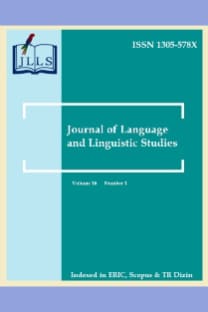Fonetik transkripsiyonun İran EFL öğrencilerinin kelime vurgusu öğrenmelerine etkisi
The effect of phonetic transcription on Iranian EFL students' word stress learning
___
- Arciuli, J., Monaghan, P. & Seva, N. (2010). Learning to assign lexical stress duringreading aloud: Corpus, behavioral, and computational investigations .Journal of Memory and Language, 63(2), 180–196.
- Brown, D. (2001). Teaching by principles: An interactive approach to language pedagogy (2nd edition). USA: Addison Wesely Longman, Inc.
- Brown, H. D. (2007). Principles of language learning and teaching (5th ed.). NewYork: Pearson.
- Celce-Murcia, M., Brinton, D., & Goodwin, J. (1996). Teaching pronunciation: A reference for teachers of English to speakers of other languages. New York: Cambridge University Press.
- Chastain, K. (1976). Developing Second Language Skills: Theory to Practice. Chicago: Rand McNally Publishing Co.
- Dalton, D.F. (1997). Some techniques for listening pronunciation. The Internet TESL Journal. 3(1). Available online at http://iteslj.org/.
- Farhady, H., Jafarpoor, A., & Birjandi, P. (1994). Testing language skills: From theory to practice. Tehran: SAMT Publications.
- Flege, J.E. (2002). Interactions between the Native and Second-language Phonetic Systems. In Burmeister, P., Piske, T. & Rohde, A. (Eds.), An Integrated View of Language Development: Papers in Honor of Henning Wode (pp. 217-244). Trier: Wissenschaftlicher Verlag.
- Fullana, N. (2006). The Development of English (FL) Perception and Production Skills: Starting Age and Exposure Effects. In Muñoz, C. (Ed.), Age and the Rate of Foreign Language Learning (pp. 41-64). Clevedon: Multilingual Matters.
- Ghorbani, M. R. (2011). The impact of phonetic instruction on Iranian students’ listening ability enhancement. Asian EFL Journal, 52, 24-34.
- Ghorbani, M. R., Neissari, M. & Kargozari, H. R. (2016). The effect of explicit pronunciation instruction on undergraduate English as a foreign language learners' vowel perception. Language and Literacy, 18(1), 57-70.
- Ghorbani, M. R. & Neissari, M. (2015). Washback effect of the Iranian concours on senior high school students' EFL learning activities. Iranian Journal of Language Testing, 5(1), 1-28.
- Hartoyo (2008). Individual Differences in Computer-Assisted Language Learning. Semarang: Pelita Insani Semarang.
- Heidari Shahreza, M. A. & Moinzadeh, A. (2012). Teaching Word Stress Patterns Of English Using A Musically-simulated Technique GEMA Online™ Journal of Language Studies, 12(2), 521-537.
- Hayati, A. M. (2010). Notes on teaching English pronunciation to EFL learners: A case of Iranian high school students. English Language Teaching, 3(4), 121-126.
- Hayati, A.M. (2008). Teaching English pronunciation to Iranian students: Problems and suggestions. Available online at http://www.esljournal.org/62926768.html
- Hosseini, S. M. H. (2007). ELT in higher education in Iran and India – A critical view.Language in India, 7, 1-11.Retrieved October 9, 2008, from http://www. languageinindia.com /dec2007/eltinindiaandiran.pdf
- Jahangard, A. (2007). Evaluation of EFL materials taught at Iranian public high schools. The Asian EFL Journal, 9 (2), 130-150.
- Kelly, G. (2000). How to teach pronunciation. Malaysia: Pearson Education Ltd.
- Ladefoged, P. (2006). A course in phonetics (5th ed.). Forth Worth: Harcourt, Brace, Jovanovich.
- Lenneberg, E. H. (1967). Biological foundations of language. New York: John Wiley & Sons, Inc.
- Lord, G. (2005). (How) Can we teach Foreign language pronunciation? On the effects of a Spanish phonetics course. Hispania, 88(3), 557-567.
- Murphy, J.M. (2004). Attending to word-stress while learning new vocabulary. English for Specific Purposes Journal, 24(3), 756–766.
- Nunan, D. (2004). Task-based language teaching. Cambridge, UK: Cambridge University Press.
- Okita, Y. (1999). Teaching Pronunciation. English Teaching Forum. 37(1), p.16. dosfan.lib.uic.edu/usia/E-USIA/forum/vols/vol37/no1/p16.htm.
- Pourhosein Gilakjani, A. (2012). The significance of pronunciation teaching in English language teaching. English Language Teaching 5, 96-107.
- Rafiee, A. (2001). Colloquial Persian: The complete course for beginners. London: Rutledge. Snowling, M. J. & Hulme, C. (2011). Evidence-based interventions for reading and language difficulties: creating a virtuous circle. British Journal of Educational Psychology, 81(1), 1-23.
- Swan, M., & Smith, B. (2001). Learner English: A teacher's guide to interference and other problems, (Vol. 1). United Kingdom: Cambridge University Press.
- Razmjo, S. A. & Riazi, M. (2006). Is communicative language teaching practical in the expanding circle? A case study of teachers of Shiraz high schools and institutes. Journal of Language and Learning, 4 (2), 144-171.
- Tominaga, Y. (2011). An analysis of English pronunciation of Japanese learners: From the viewpoint of EIL. Journal of Pan-Pacific Association of Applied Linguistics, 15(2), 45-57.
- Wells, J.C. (1996). Why phonetic transcription is important. Journal of the Phonetic Society of Korea, 31(32), 239-242.
- Werfel, K. L. (2017). Phonetic transcription training improves adults’ explicit phonemic awareness: Evidence from undergraduate students. Communication Disorders Quarterly 39(1) 281–287.
- Wenden, A. (1992). Learner strategies for learner autonomy. Englewood Cliffs, NJ: Prentice-Hall.
- Yarmohammadi, L. (2005). A contrastive phonological analysis of English and Persian. (3rd ed.). Shiraz: Shiraz University Press.
- Yarmohammadi, L. 2000. A contrastive phonological analysis of English and Persian. Iran: Shiraz University Press.
- Yarmohammadi, L. (1995). A contrastive phonological analysis of English and Persian: A course book in applied phonological studies. Shiraz: Shiraz University Press.
- Yu, V. Y., & Andruski, J. E. (2010). A cross-language study of perception of lexical stress in English. Journal of Psycholinguist Research, 39(4), 323–344.
- Ziegler, J. C. & Goswami, U. (2005). Reading acquisition, developmental dyslexia, and skilled reading across languages: a psycholinguistic grain size theory. Psychological Bulletin, 131(1), 3- 29.
- Zorzi, M. (2010). The connectionist dual process (CDP) approach to modelling reading aloud. European Journal of Cognitive Psychology, 22(5), 836-860.
- ISSN: 1305-578X
- Yayın Aralığı: 4
- Başlangıç: 2005
- Yayıncı: http://www.jlls.org
Dil değişimi: Pakistan reklamlarında kod karıştırma ve kod değiştirme
Fonetik transkripsiyonun İran EFL öğrencilerinin kelime vurgusu öğrenmelerine etkisi
İngilizce derslerinde dil alaşımı: Öğretmenlerin tutumları ve uygulamaları
İngilizce sesletim öğretimi ile ilgili makaleler üzerine bir içerik çözümlemesi
Çocuk dilinde olumsuz ifadelerin edinimi ve kullanımı
